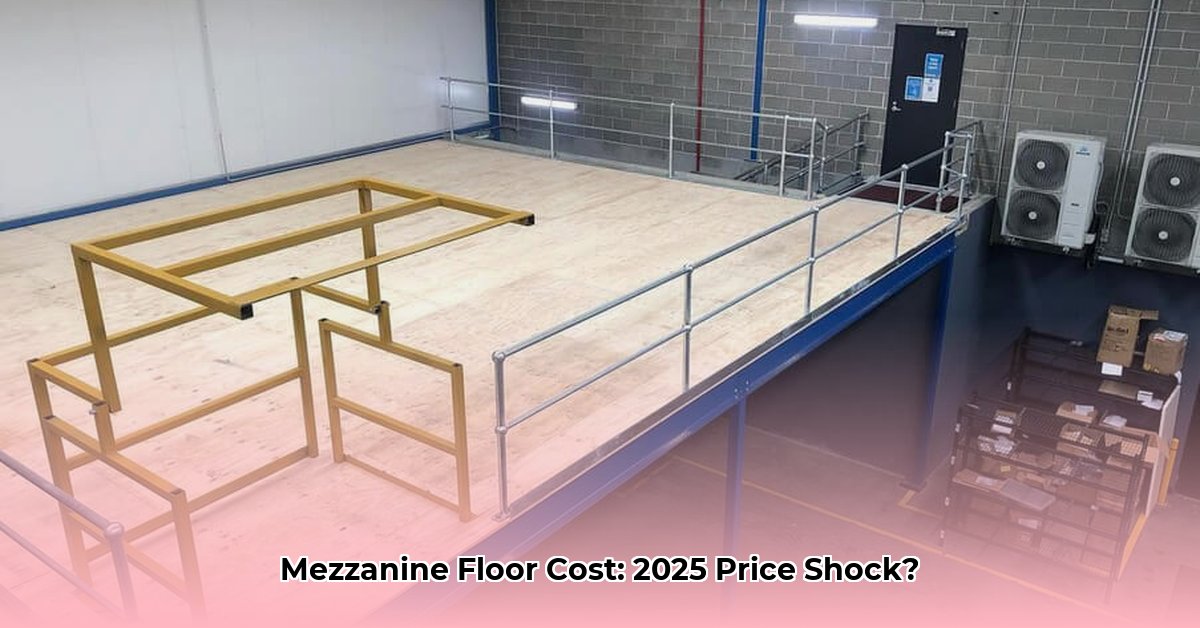Adding a mezzanine floor can significantly enhance your space, whether for residential or commercial purposes. Understanding the cost per square meter is crucial for effective budgeting. This guide provides a comprehensive overview of the factors influencing mezzanine floor costs in 2025, helping you make informed decisions. For a basic understanding of what a mezzanine floor is, check out this helpful resource: Mezzanine floor definition. Knowing the intricacies of these costs ensures your project is both affordable and successful.
Mezzanine Floor Cost Per Square Meter: Your 2025 Guide
The cost per square meter of a mezzanine floor varies widely, influenced by various factors. This guide aims to clarify these factors and provide effective budgeting strategies. Proper planning and understanding can lead to a cost-efficient and valuable addition to your space. Let’s explore how various considerations impact pricing, enabling informed decisions for your project.
Factors Affecting Your Mezzanine’s Price Tag
Several factors influence the cost of a mezzanine floor, including size, materials, design complexity, load capacity, location, intended use, and compliance with local building codes. Each of these elements plays a significant role in determining the overall price, so it’s essential to understand their impact.
- Size Matters: While larger mezzanines may benefit from economies of scale, smaller, custom spaces can sometimes be more expensive per square meter due to intricate design or specialized materials.
- Materials: Steel, aluminum, wood, and composite materials offer different aesthetics, durability, and price points. Steel is valued for its sturdiness, wood offers warmth, aluminum is lightweight and corrosion-resistant, and composites can mimic other materials at a lower cost. Your choice will significantly impact the final price.
- Design: Simple rectangular designs are cheaper and faster to install than complex ones with custom features like winding staircases, integrated lighting, glass railings, or unique shapes.
- Load Capacity: The weight your mezzanine needs to support significantly impacts construction costs; light storage or office space is cheaper than heavy machinery or retail stock storage. Engineering and reinforcement costs increase with higher load requirements.
- Location: Construction costs, labor rates, material availability, and accessibility vary by location. Urban centers with strict building codes or difficult access are generally more expensive than rural areas.
- Purpose: Home mezzanines may prioritize aesthetics and custom finishes, while commercial mezzanines prioritize strength, functionality, and adherence to stringent industrial or commercial building codes.
- Building Codes & Permits: Compliance with local building codes, fire safety regulations, and accessibility standards (ADA in the US) requires additional investment in design, materials, and safety features like fire-resistant coatings, emergency exits, and handrails.
Breaking Down the Costs: A Realistic Look
Estimating the price accurately requires a detailed breakdown of components. The table below provides cost ranges and influencing factors to give you a better idea. Always remember that these are estimates, and actual costs will vary; obtaining multiple quotes is critical.
| Component | Cost Range (per sq m) | What Influences This Cost? |
|---|---|---|
| Materials | $60 – $300+ | Type of material (steel, wood, aluminum, composites), quality, market prices, finishes (e.g., powder coating, staining), fireproofing treatments. |
| Labor | $60 – $200+ | Skilled labor is expensive; location, union vs. non-union labor, complexity of installation, site accessibility, and time of year (seasonal demand) also affect pay rates. |
| Design & Engineering | $30 – $100+ | Complexity of the design, structural calculations, fire safety design, accessibility compliance, stamped engineered drawings, soil testing (if required for foundation work). |
| Permits & Inspections | $15 – $75+ | Local regulations, plan review fees, inspections by building inspectors, fire marshals, and accessibility specialists, potential delays due to code revisions or corrections needed. |
| Contingency | 10-20% of total cost | Unexpected issues always pop up; better safe than sorry. Examples: unforeseen structural issues, material delays, weather-related delays, change orders requested by the client, and errors in initial estimates. |
| Additional Features & Finishes | Varies Widely | Staircases, railings, lighting, HVAC integration, electrical outlets, flooring (e.g., carpet, epoxy), soundproofing, fire suppression systems (sprinklers), lifts or elevators, decorative elements, and specialized coatings all add to the cost. |
Important Note: The cost ranges are broad due to the many factors involved. Always get multiple quotes for comparison. Costs can also fluctuate based on economic conditions, material tariffs, and supply chain disruptions.
Your Step-by-Step Mezzanine Budget Guide
Creating an accurate budget involves several key steps. Following these steps will help you estimate your mezzanine floor costs effectively:
- Define Project Scope Thoroughly: Clearly define the purpose of the mezzanine, its size, load requirements, intended use, and desired aesthetics before seeking quotes. The more detailed your specifications, the more accurate your estimates will be.
- Get Several Quotes: Request detailed, itemized quotes from at least three reputable contractors specializing in mezzanine construction. Ensure each quote includes a breakdown of material costs, labor charges, design fees, permit expenses, and contingency allowances.
- Navigate Permits: Research local building codes, zoning regulations, and permit requirements early in the process. Obtain all necessary permits before construction begins to avoid costly delays, fines, or legal issues.
- Material Choices: Consider your budget, intended use, and desired aesthetics when selecting materials. Balance cost-effectiveness with durability, maintenance requirements, and aesthetic appeal. Explore alternative materials or finishes to reduce costs without compromising quality.
- Value Engineering: Work with your contractor to identify opportunities to reduce costs through value engineering. This involves analyzing design options, material choices, and construction methods to find the most cost-effective solutions without sacrificing performance or safety.
- The Unexpected: Build in a contingency fund (10-20% of the total estimated cost) to cushion against surprise expenses. Unforeseen issues, such as hidden structural problems, material price increases, or weather-related delays, can quickly escalate project costs.
- Financing Options: Explore financing options, such as loans, leases, or grants, to help cover the cost of your mezzanine project. Compare interest rates, repayment terms, and eligibility requirements to find the best financing solution for your needs.
Choosing the Right Contractor: Partnering for Success
Selecting a reliable contractor is key to a smooth project. Look for these qualities in a contractor:
- Verify Credentials: Check their licenses, insurance, and bonding to ensure they are legitimate, qualified, and financially responsible.
- Check References: Contact past clients to inquire about their experience with the contractor. Ask about their communication skills, project management abilities, and ability to stay on schedule and within budget.
- Portfolio Review: Look at photos of their previous mezzanine projects to assess the quality of their work and their experience with similar types of installations.
- Contract Clarity: Read the contract carefully, ensuring you understand all terms and conditions, payment schedules, change order procedures, warranty provisions, and dispute resolution mechanisms. Consult with an attorney to review the contract before signing.
- Communication & Transparency: Choose a contractor who communicates clearly, responds promptly to your questions, and provides transparent pricing and project updates throughout the construction process.
Navigating the Mezzanine Maze: Final Thoughts
Accurately estimating the cost of your mezzanine requires understanding all contributing factors. Thorough planning, professional advice, and detailed budgeting are essential. Don’t forget long-term maintenance and potential future upgrades. This initial investment should be viewed as a long-term enhancement to the space. Consider future needs and design the mezzanine to accommodate potential expansion or modifications.
How to Get Accurate Mezzanine Floor Cost Estimates for Commercial Projects
Understanding the variables and creating a detailed plan are crucial for accurate cost estimation. Choosing the right contractor ensures a smooth and successful installation, leading to the best possible outcome for your investment.
Key Takeaways:
- Mezzanine floor costs can range from $60 to $300+ per square meter, contingent on design, materials, and local building codes.
- Critical factors include size, materials, design complexity, location, labor, permits, and compliance with accessibility and fire safety regulations.
- Accurate cost estimation needs detailed project specifications, stamped engineered drawings, and professional consultation and advice from experienced mezzanine contractors and structural engineers.
- Obtaining multiple, itemized quotes from reputable contractors is crucial for cost management and transparency.
- Thorough planning, budgeting, and value engineering are essential for successful project completion within your budget constraints.
Understanding the Variables
Getting an accurate estimate for your mezzanine project involves understanding the many influencing factors. These factors include materials, design, installation costs, and the complexity of complying with local building codes. Ignoring small factors can lead to big budget problems.
The square footage is a starting point, but material choices significantly impact the price. Steel is often the most economical for commercial projects requiring high load capacities, while wood or composite materials may be preferred for office spaces or retail environments where aesthetics are more important. Consider the material based on your budget, design needs, and functional requirements.
Design complexity adds another layer
- Gray Kitchen Backsplash Ideas: Find Your Perfect Gray Tile - December 11, 2025
- Glass Wall Tiles For Bathroom: A Stylish, Durable Choice - December 10, 2025
- Glass Mosaic Kitchen Backsplash: Add Shimmer and Style - December 9, 2025









